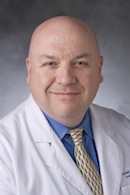 Michael W. Manning, MD, PhD
Michael W. Manning, MD, PhD
Duke University Medical Center
Durham, NC
Dr. Manning’s Research
Mechanisms In the Development of Post Operative Atrial Fibrillation
Postoperative atrial fibrillation (POAF) occurs in 40%-60% of patients and is the most common complication following cardiac surgery; it is associated with increased length of stay, stroke, and both short- and long-term mortality. Few treatments for POAF are available, there are no prevention strategies. Given the increase in cardiac surgeries, development of prevention strategies is necessary to reduce the impact of POAF. A key factor in POAF development may be inflammation. The exact mechanism by which inflammation influences POAF is unknown, however, one potential mediator is angiotensin II (AngII). All of the components of the renin-angiotensin system (RAS) are present in the heart, and become up-regulated during ischemia. AngII may act in both a paracrine and autocrine manner to promote local inflammation, oxidative stress, fibrosis, and hypertrophy. Blocking AngII signaling with angiotensin receptor blockers decreases inflammation-related damage after MI. While similarities exist between the inflammatory processes of acute MI and cardiac surgery, it has not been directly evaluated as a factor in POAF.
The central hypothesis is AngII is produced within the myocardium in association with CPB and ischemia/reperfusion (CPB-I/R), and triggers the pro-inflammatory and pro-fibrotic arrhythmogenic mechanisms underlying the acute development of POAF following cardiac surgery. Dr. Manning and his team will focus on: 1) AngII production during CPB; 2) role of AngII in cardiac inflammation; and 3) determining whether AngII functions as a primary or secondary regulator in development of POAF. As anesthesiologists working in the preoperative period, Dr. Manning’s team has the unique ability to study this critical complication as well as initiate preventative therapies. The objective of these studies is to deconstruct the major cellular contributors of inflammation and identify pharmacologically modifiable points in the pathway to allow new interventions to prevent POAF and improve patient outcomes.
2013 SCA-IARS Starter Grant
Atrial fibrillation following cardiopulmonary bypass: The role of angiotensin II.
Related Publications
Differential effects of doxycycline, a broad-spectrum matrix metalloproteinase inhibitor, on angiotensin II-induced atherosclerosis and abdominal aortic aneurysms.
Manning MW, Cassis LA, Daugherty A.
Angiotensin II (AngII) infusion into hyperlipidemic mice leads to the rapid formation of atherosclerotic lesions and abdominal aortic aneurysms (AAAs). To define the role of matrix metalloproteinases (MMPs) in the development of these vascular pathologies, we administered the broad-spectrum MMP inhibitor doxycycline to saline- and AngII-infused LDL receptor-/- mice.
Read Dr. Manning’s recent publications and articles.
International Anesthesia Research Society
